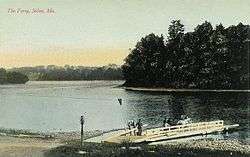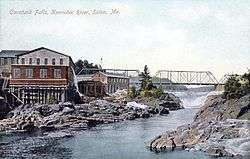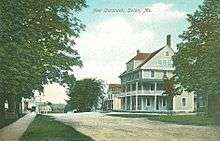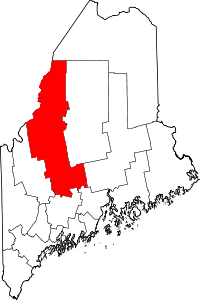Solon, Maine
Solon is a town in Somerset County, Maine, United States. The population was 1,053 at the 2010 census.
Solon, Maine | |
|---|---|
 Kennebec River c. 1908 | |
 Solon, Maine Location within the state of Maine | |
| Coordinates: 44°56′26″N 69°48′27″W | |
| Country | United States |
| State | Maine |
| County | Somerset |
| Incorporated | 1809 |
| Area | |
| • Total | 40.74 sq mi (105.52 km2) |
| • Land | 39.65 sq mi (102.69 km2) |
| • Water | 1.09 sq mi (2.82 km2) |
| Elevation | 499 ft (152 m) |
| Population | |
| • Total | 1,053 |
| • Estimate (2012[3]) | 1,061 |
| • Density | 26.6/sq mi (10.3/km2) |
| Time zone | UTC-5 (Eastern (EST)) |
| • Summer (DST) | UTC-4 (EDT) |
| ZIP code | 04979 |
| Area code(s) | 207 |
| FIPS code | 23-69505 |
| GNIS feature ID | 0582728 |
History

The first known inhabitants were the Abenaki Indians, whom European settlers encountered in the early 1600s. There are petroglyphs that have been said to be 5,000 years old or more, but more than likely came about after 1620. General Benedict Arnold and his troops camped below Caratunk Falls on October 7, 1775, before carrying their boats around them on the way up the Kennebec River to the Battle of Quebec. Originally called T1 R2 EKR, the plantation was known as Spauldingtown after Thomas Spaulding, a grantee. It was settled in 1782 by William Hilton from Wiscasset, who purchased 500 acres (2.0 km2). On February 23, 1809, it was incorporated as Solon, named after Solon, a statesman and poet of Ancient Greece.[4]
Agriculture was the principal occupation of the inhabitants. The surface of the town is uneven, the underlying rock is slate, but the sandy and occasionally gravelly loam produced good crops of hay and grain. Solon village was established at Fall Brook, its water power used to operate mills. By 1859, when the population was 1,419, there were two sawmills, a gristmill, a shovel handle factory, two fulling and two carding machines, and two blacksmiths.[4] By 1886, the town's industries included a carriage manufacturer and a harness maker.[5]
Solon is the gateway to the Old Canada Road (U. S. Route 201), which from 1820 until 1860 served as the primary link between Lower Canada and Maine. The byway follows the Kennebec River valley through various villages and into the forests near the Canada–US border.[6]
Geography
According to the United States Census Bureau, the town has a total area of 40.74 square miles (105.52 km2), of which, 39.65 square miles (102.69 km2) of it is land and 1.09 square miles (2.82 km2) is water.[1] Solon is drained by Fall Brook, Michael Stream and the Kennebec River, where Caratunk Falls has a descent of 20 feet (6.1 m).
The town is crossed by U.S. Route 201, 201A and Maine State Route 8. It borders the towns of Bingham and Brighton Plantation to the north, Athens to the east, Cornville and Madison to the south, and Embden to the west.
Demographics
| Historical population | |||
|---|---|---|---|
| Census | Pop. | %± | |
| 1800 | 38 | — | |
| 1810 | 312 | 721.1% | |
| 1820 | 468 | 50.0% | |
| 1830 | 768 | 64.1% | |
| 1840 | 1,139 | 48.3% | |
| 1850 | 1,415 | 24.2% | |
| 1860 | 1,345 | −4.9% | |
| 1870 | 1,176 | −12.6% | |
| 1880 | 1,013 | −13.9% | |
| 1890 | 977 | −3.6% | |
| 1900 | 996 | 1.9% | |
| 1910 | 1,034 | 3.8% | |
| 1920 | 1,054 | 1.9% | |
| 1930 | 852 | −19.2% | |
| 1940 | 773 | −9.3% | |
| 1950 | 746 | −3.5% | |
| 1960 | 669 | −10.3% | |
| 1970 | 712 | 6.4% | |
| 1980 | 827 | 16.2% | |
| 1990 | 916 | 10.8% | |
| 2000 | 940 | 2.6% | |
| 2010 | 1,053 | 12.0% | |
| Est. 2014 | 1,047 | [7] | −0.6% |
| U.S. Decennial Census[8] | |||
2010 census
As of the census[2] of 2010, there were 1,053 people, 459 households, and 292 families living in the town. The population density was 26.6 inhabitants per square mile (10.3/km2). There were 657 housing units at an average density of 16.6 per square mile (6.4/km2). The racial makeup of the town was 97.9% White, 0.2% African American, 0.4% Native American, 0.1% Asian, and 1.4% from two or more races. Hispanic or Latino of any race were 0.4% of the population.
There were 459 households of which 26.4% had children under the age of 18 living with them, 52.5% were married couples living together, 5.9% had a female householder with no husband present, 5.2% had a male householder with no wife present, and 36.4% were non-families. 27.0% of all households were made up of individuals and 8.3% had someone living alone who was 65 years of age or older. The average household size was 2.29 and the average family size was 2.75.
The median age in the town was 45.4 years. 20.1% of residents were under the age of 18; 5.1% were between the ages of 18 and 24; 24.2% were from 25 to 44; 35.6% were from 45 to 64; and 15.1% were 65 years of age or older. The gender makeup of the town was 52.6% male and 47.4% female.
2000 census
As of the census[9] of 2000, there were 940 people, 398 households, and 257 families living in the town. The population density was 23.6 people per square mile (9.1/km2). There were 581 housing units at an average density of 14.6 per square mile (5.6/km2). The racial makeup of the town was 98.83% White, 0.43% Black, 0.21% Native American, 0.11% Asian, and 0.43% from two or more races. Hispanic or Latino of any race were 0.43% of the population.
There were 398 households out of which 27.1% had children under the age of 18 living with them, 53.0% were married couples living together, 6.5% had a female householder with no husband present, and 35.4% were non-families. 27.1% of all households were made up of individuals and 9.5% had someone living alone who was 65 years of age or older. The average household size was 2.34 and the average family size was 2.82.

In the town, the population was spread out with 21.9% under the age of 18, 7.3% from 18 to 24, 26.5% from 25 to 44, 30.3% from 45 to 64, and 13.9% who were 65 years of age or older. The median age was 42 years. For every 100 females, there were 113.6 males. For every 100 females age 18 and over, there were 109.7 males.
The median income for a household in the town was $27,266, and the median income for a family was $32,500. Males had a median income of $25,724 versus $16,574 for females. The per capita income for the town was $13,777. About 12.1% of families and 18.0% of the population were below the poverty line, including 21.9% of those under age 18 and 15.3% of those age 65 or over.
Stereographic cards
Stereoscopic photographs of Solon from the Victorian era:
 Solon village
Solon village Main Street
Main Street_L._Pierce%2C_Solon%2C_Maine%2C_from_Robert_N._Dennis_collection_of_stereoscopic_views.jpg) Pierce residence
Pierce residence Jewett residence
Jewett residence Whipple residence
Whipple residence_Falls%2C_Solon%2C_Maine%2C_from_Robert_N._Dennis_collection_of_stereoscopic_views.jpg) Logs on Caratunk Falls
Logs on Caratunk Falls
Sites of interest
Notable people
- George Washburn, pitcher with the New York Yankees (1941)
References
- "US Gazetteer files 2010". United States Census Bureau. Retrieved 2012-12-16.
- "U.S. Census website". United States Census Bureau. Retrieved 2012-12-16.
- "Population Estimates". United States Census Bureau. Archived from the original on 2013-06-11. Retrieved 2013-07-06.
- Coolidge, Austin J.; John B. Mansfield (1859). A History and Description of New England. Boston, Massachusetts: A.J. Coolidge. pp. 305–306.
coolidge mansfield history description new england 1859.
- Varney, George J. (1886), Gazetteer of the state of Maine. Solon, Boston: Russell
- Old Canada Road Scenic Byway
- "Annual Estimates of the Resident Population for Incorporated Places: April 1, 2010 to July 1, 2014". Archived from the original on May 23, 2015. Retrieved June 4, 2015.
- "Census of Population and Housing". Census.gov. Retrieved June 4, 2015.
- "U.S. Census website". United States Census Bureau. Retrieved 2008-01-31.
External links
| Wikimedia Commons has media related to Solon, Maine. |
